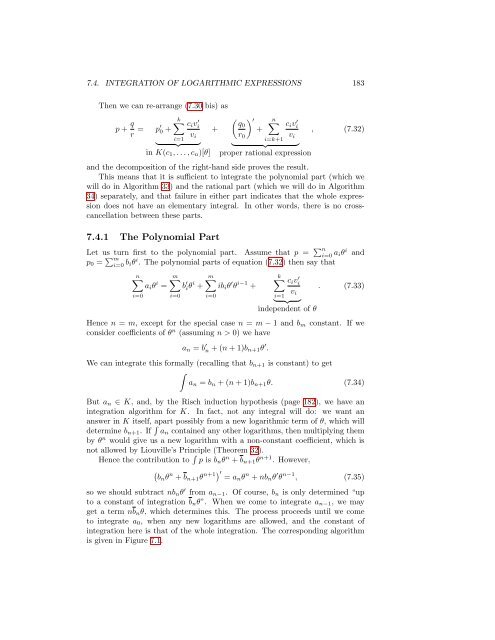Contents - Student subdomain for University of Bath
Contents - Student subdomain for University of Bath
Contents - Student subdomain for University of Bath
You also want an ePaper? Increase the reach of your titles
YUMPU automatically turns print PDFs into web optimized ePapers that Google loves.
7.4. INTEGRATION OF LOGARITHMIC EXPRESSIONS 183<br />
Then we can re-arrange (7.30 bis) as<br />
(<br />
q0<br />
p + q k∑<br />
r = c i v ′ ) ′ n∑<br />
p′ i<br />
c i v i<br />
′<br />
0 +<br />
+ +<br />
, (7.32)<br />
v<br />
i=1 i<br />
r 0 v i<br />
i=k+1<br />
} {{ } } {{ }<br />
in K(c 1 , . . . , c n )[θ] proper rational expression<br />
and the decomposition <strong>of</strong> the right-hand side proves the result.<br />
This means that it is sufficient to integrate the polynomial part (which we<br />
will do in Algorithm 33) and the rational part (which we will do in Algorithm<br />
34) separately, and that failure in either part indicates that the whole expression<br />
does not have an elementary integral. In other words, there is no crosscancellation<br />
between these parts.<br />
7.4.1 The Polynomial Part<br />
Let us turn first to the polynomial part. Assume that p = ∑ n<br />
i=0 a iθ i and<br />
p 0 = ∑ m<br />
i=0 b iθ i . The polynomial parts <strong>of</strong> equation (7.32) then say that<br />
n∑<br />
m∑ m∑<br />
a i θ i = b ′ iθ i + ib i θ ′ θ i−1 +<br />
i=0<br />
i=0<br />
i=0<br />
k∑<br />
i=1<br />
c i v ′ i<br />
v i<br />
} {{ }<br />
independent <strong>of</strong> θ<br />
. (7.33)<br />
Hence n = m, except <strong>for</strong> the special case n = m − 1 and b m constant. If we<br />
consider coefficients <strong>of</strong> θ n (assuming n > 0) we have<br />
a n = b ′ n + (n + 1)b n+1 θ ′ .<br />
We can integrate this <strong>for</strong>mally (recalling that b n+1 is constant) to get<br />
∫<br />
a n = b n + (n + 1)b n+1 θ. (7.34)<br />
But a n ∈ K, and, by the Risch induction hypothesis (page 182), we have an<br />
integration algorithm <strong>for</strong> K. In fact, not any integral will do: we want an<br />
answer in K itself, apart possibly from a new logarithmic term <strong>of</strong> θ, which will<br />
determine b n+1 . If ∫ a n contained any other logarithms, then multiplying them<br />
by θ n would give us a new logarithm with a non-constant coefficient, which is<br />
not allowed by Liouville’s Principle (Theorem 32).<br />
Hence the contribution to ∫ p is b n θ n + b n+1 θ n+1 . However,<br />
(<br />
bn θ n + b n+1 θ n+1) ′<br />
= an θ n + nb n θ ′ θ n−1 , (7.35)<br />
so we should subtract nb n θ ′ from a n−1 . Of course, b n is only determined “up<br />
to a constant <strong>of</strong> integration b n θ”. When we come to integrate a n−1 , we may<br />
get a term nb n θ, which determines this. The process proceeds until we come<br />
to integrate a 0 , when any new logarithms are allowed, and the constant <strong>of</strong><br />
integration here is that <strong>of</strong> the whole integration. The corresponding algorithm<br />
is given in Figure 7.1.












![[Luyben] Process Mod.. - Student subdomain for University of Bath](https://img.yumpu.com/26471077/1/171x260/luyben-process-mod-student-subdomain-for-university-of-bath.jpg?quality=85)



